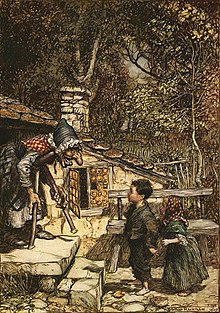| This article needs additional citations for verification. Please help improve this article by adding citations to reliable sources. Unsourced material may be challenged and removed. Find sources: "German folklore" – news · newspapers · books · scholar · JSTOR (April 2024) (Learn how and when to remove this message) |
|
Architecture |

German folklore is the folk tradition which has developed in Germany over a number of centuries. Seeing as Germany was divided into numerous polities for most of its history, this term might both refer to the folklore of Germany proper and of all German-speaking countries, this wider definition including folklore of Austria and Liechtenstein as well as the German-speaking parts of Switzerland, Luxembourg, Belgium, and Italy.
Characteristics
It shares many characteristics with Nordic folklore and English folklore due to their origins in a common Germanic mythology. It reflects a similar mix of influences: a pre-Christian pantheon and other beings equivalent to those of Norse mythology; magical characters (sometimes recognizably pre-Christian) associated with Christian festivals, and various regional 'character' stories.
As in Scandinavia, when belief in the old gods disappeared, remnants of the mythos persisted: There are:
- Frau Holle or Perchta, a "supernatural" patron of spinning and leader of the Wild Hunt (in German folklore preceded by an old man, Honest Eckart, who warns others of its approach) or of the Heimchen
- solitary wild huntsmen such as the ewiger Jäger or the Türst
- the Lorelei, a dangerous Rhine siren derived from 19th-century literature, among other nixies such as the Rhinemaidens
- the Weiße Frauen and Witte Wiwer, white female spirits
- the Doppelgänger, supernatural beings said to resemble the exactly similar appearance of determined person
- the giant Rübezahl
- the mining sprite Bergmönch
- wood sprites such as the tiny Moss people and their matriarch Buschgroßmutter, or the man-eating Fänggen
- nightmare-causing Alp, mare, and Drude
- the banshee Klagmuhme
- undead Nachzehrer and Wiedergänger
- ghostly Feuermann, Hemann, and Uhaml
- changeling legends
and many more generic entities such as the elf, dwarf, Kobold (with variants such as Bieresel, Gütel, Heinzelmännchen, Jack o' the bowl, and Niß Puk), Klabautermann, Schrat, Wild man, Drak, Aufhocker, Ork, poltergeist, bogeyman, Will-o'-the-wisp, various Feldgeister, and Erlking. Famous individual Kobolds are King Goldemar, Hinzelmann, Hödekin, and Petermännchen.
There further are mythical animals such as Bahkauv, Beerwolf, Elwetritsch, Erdhenne, lindworm, Nachtkrapp, Rasselbock, Tatzelwurm, and Wolpertinger, or mythical plants such as Alraune and Irrwurz.
Popular folklore includes Krampus, Belsnickel, and Knecht Ruprecht, a rough companion to Santa Claus; the Lutzelfrau, a Yule witch who must be appeased with small presents; the Christkind; the Osterhase (Easter Hare – the original Easter Bunny); and Walpurgisnacht, a spring festival derived from pagan customs.
Character folklore includes the stories of the Pied Piper of Hamelin, the Godfather Death, the trickster hero Till Eulenspiegel, the Town Musicians of Bremen and Faust.
History
Documentation and preservation of folklore in the states that formally united as Germany in 1871 was initially fostered in the 18th and 19th centuries. As early as 1851, author Bernhard Baader published a collection of folklore research obtained by oral history, called Volkssagen aus dem Lande Baden und den angrenzenden Gegenden. The Saxon author Johann Karl August Musäus (1735–1787) was another early collector.
Study was further promoted by the Prussian poet and philosopher Johann Gottfried von Herder. His belief in the role of folklore in ethnic nationalism – a folklore of Germany as a nation rather than of disunited German-speaking peoples – inspired the Brothers Grimm, Goethe and others. For instance, folklore elements, such as the Rhine Maidens and the Grimms' The Story of a Boy Who Went Forth to Learn Fear, formed part of the source material for Richard Wagner's opera cycle Der Ring des Nibelungen.
Some of the works of Washington Irving – notably "Rip van Winkle" and "The Legend of Sleepy Hollow" – are based on German folktales.
Within Germany, the nationalistic aspect was further emphasized during the National Socialist era. James R. Dow has written that under National Socialism, "folklore became a propaganda instrument of anti-democratic, anti-socialist, and extremely inhumane terrorist policies". Folklore studies, Volkskunde, were co-opted as a political tool, to seek out traditional customs to support the idea of historical continuity with a Germanic culture. Anti-Semitic folklore such as the blood libel legend was also emphasized.
See also
References
- Hart, Moriah (Spring–Summer 2009). "Reviewed Work: German Folklore: A Handbook by James R. Dow". Western Folklore. 68 (2/3): 334–335. JSTOR 40600558.
External links
- Johann Karl August Musäus Projekt Gutenberg DE (in German)
- German Fairy Tales and Folklore Collected by Fairytales (in English)
| Folklore of Europe | |
|---|---|
| Sovereign states |
|
| States with limited recognition | |
| Dependencies and other entities | |